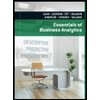Specialty Toys, Inc., sells a variety of new and innovative children’s toys. Management learned that thepreholiday season is the best time to introduce a new toy, because many families use this time to look fornew ideas for December holiday gifts. When Specialty discovers a new toy with good market potential, itchooses an October market entry date.In order to get toys in its stores by October, Specialty places one-time orders with itsmanufacturers in June or July of each year. Demand for children’s toys can be highly volatile. If a newtoy catches on, a sense of shortage in the marketplace often increases the demand to high levels and largeprofits can be realized. However, new toys can also flop, leaving Specialty stuck with high levels ofinventory that must be sold at reduced prices. The most important question the company faces is decidinghow many units of a new toy should be purchased to meet anticipated sales demand. If too few arepurchased, sales will be lost; if too many are purchased, profits will be reduced because of low pricesrealized in clearance sales.For the coming season, Specialty plans to introduce a new product called Weather Teddy. Thisvariation of a talking teddy bear is made by a company in Taiwan. When a child presses Teddy’s hand,the bear begins to talk. A built-in barometer selects one of five responses that predict the weatherconditions. The responses range from “It looks to be a very nice day! Have fun” to “I think it may raintoday. Don’t forget your umbrella.” Tests with the product show that, even though it is not a perfectweather predictor, its predictions are surprisingly good. Several of Specialty’s managers claimed Teddygave predictions of the weather that were as good as many local television weather forecasters.As with other products, Specialty faces the decision of how many Weather Teddy units to orderfor the coming holiday season. Members of the management team suggested order quantities of 15,000,18,000, 24,000, or 28,000 units. The wide range of order quantities suggested indicates considerabledisagreement concerning the market potential. The product management team asks you for an analysis ofthe stock-out probabilities for various order quantities, an estimate of the profit potential, and to helpmake an order quantity recommendation. Specialty expects to sell Weather Teddy for $24 based on a costof $16 per unit. If inventory remains after the holiday season, Specialty will sell all surplus inventory for$5 per unit. After reviewing the sales history of similar products, Specialty’s senior sales forecasterpredicted an expected demand of 20,000 units with a .95 probability that demand would be between10,000 units and 30,000 units.Managerial ReportPrepare a managerial report that addresses the following issues and recommends an order quantity for theWeather Teddy product.. One of Specialty’s managers felt that the profit potential was so great that the order quantityshould have a 70% chance of meeting demand and only a 30% chance of any stock-outs. What quantitywould be ordered under this policy, and what is the projected profit under the three sales scenarios?
Master Budget
A master budget can be defined as an estimation of the revenue earned or expenses incurred over a specified period of time in the future and it is generally prepared on a periodic basis which can be either monthly, quarterly, half-yearly, or annually. It helps a business, an organization, or even an individual to manage the money effectively. A budget also helps in monitoring the performance of the people in the organization and helps in better decision-making.
Sales Budget and Selling
A budget is a financial plan designed by an undertaking for a definite period in future which acts as a major contributor towards enhancing the financial success of the business undertaking. The budget generally takes into account both current and future income and expenses.
Specialty Toys, Inc., sells a variety of new and innovative children’s toys. Management learned that the
preholiday season is the best time to introduce a new toy, because many families use this time to look for
new ideas for December holiday gifts. When Specialty discovers a new toy with good market potential, it
chooses an October market entry date.
In order to get toys in its stores by October, Specialty places one-time orders with its
manufacturers in June or July of each year. Demand for children’s toys can be highly volatile. If a new
toy catches on, a sense of shortage in the marketplace often increases the demand to high levels and large
profits can be realized. However, new toys can also flop, leaving Specialty stuck with high levels of
inventory that must be sold at reduced prices. The most important question the company faces is deciding
how many units of a new toy should be purchased to meet anticipated sales demand. If too few are
purchased, sales will be lost; if too many are purchased, profits will be reduced because of low prices
realized in clearance sales.
For the coming season, Specialty plans to introduce a new product called Weather Teddy. This
variation of a talking teddy bear is made by a company in Taiwan. When a child presses Teddy’s hand,
the bear begins to talk. A built-in barometer selects one of five responses that predict the weather
conditions. The responses range from “It looks to be a very nice day! Have fun” to “I think it may rain
today. Don’t forget your umbrella.” Tests with the product show that, even though it is not a perfect
weather predictor, its predictions are surprisingly good. Several of Specialty’s managers claimed Teddy
gave predictions of the weather that were as good as many local television weather forecasters.
As with other products, Specialty faces the decision of how many Weather Teddy units to order
for the coming holiday season. Members of the management team suggested order quantities of 15,000,
18,000, 24,000, or 28,000 units. The wide range of order quantities suggested indicates considerable
disagreement concerning the market potential. The product management team asks you for an analysis of
the stock-out probabilities for various order quantities, an estimate of the profit potential, and to help
make an order quantity recommendation. Specialty expects to sell Weather Teddy for $24 based on a cost
of $16 per unit. If inventory remains after the holiday season, Specialty will sell all surplus inventory for
$5 per unit. After reviewing the sales history of similar products, Specialty’s senior sales forecaster
predicted an expected demand of 20,000 units with a .95 probability that demand would be between
10,000 units and 30,000 units.
Managerial Report
Prepare a managerial report that addresses the following issues and recommends an order quantity for the
Weather Teddy product.
. One of Specialty’s managers felt that the profit potential was so great that the order quantity
should have a 70% chance of meeting demand and only a 30% chance of any stock-outs. What quantity
would be ordered under this policy, and what is the projected profit under the three sales scenarios?
Trending now
This is a popular solution!
Step by step
Solved in 5 steps






